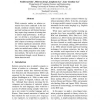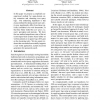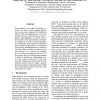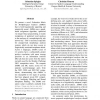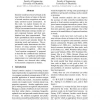COLING
2010
13 years 6 months ago
2010
This paper proposes a method that leverages multiple machine translation (MT) engines for paraphrase generation (PG). The method includes two stages. Firstly, we use a multi-pivot...
COLING
2010
13 years 6 months ago
2010
While extensive studies on relation extraction have been conducted in the last decade, statistical systems based on supervised learning are still limited because they require larg...
COLING
2010
13 years 6 months ago
2010
In this paper we propose a completely unsupervised method for open-domain entity extraction and clustering over query logs. The underlying hypothesis is that classes defined by mi...
COLING
2010
13 years 6 months ago
2010
Near-synonyms are useful knowledge resources for many natural language applications such as query expansion for information retrieval (IR) and paraphrasing for text generation. Ho...
COLING
2010
13 years 6 months ago
2010
This paper presents an approach to summarize single scientific papers, by extracting its contributions from the set of citation sentences written in other papers. Our methodology ...
COLING
2010
13 years 6 months ago
2010
We present a novel Evaluation Metric for Morphological Analysis (EMMA) that is both linguistically appealing and empirically sound. EMMA uses a graphbased assignment algorithm, op...
COLING
2010
13 years 6 months ago
2010
We describe an approach to automatically learn reordering rules to be applied as a preprocessing step in phrase-based machine translation. We learn rules for 8 different language ...
COLING
2010
13 years 6 months ago
2010
We use web-scale N-grams in a base NP parser that correctly analyzes 95.4% of the base NPs in natural text. Web-scale data improves performance. That is, there is no data like mor...
COLING
2010
13 years 6 months ago
2010
Emotion words have been well used as the most obvious choice as feature in the task of textual emotion recognition and automatic emotion lexicon construction. In this work, we exp...
COLING
2010
13 years 6 months ago
2010
We present an approach to model hidden attributes in the compositional semantics of adjective-noun phrases in a distributional model. For the representation of adjective meanings,...

